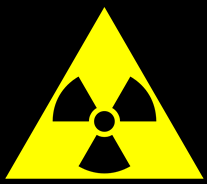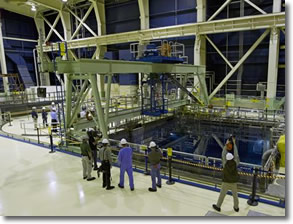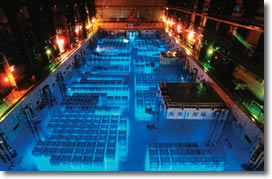» X-rays and gamma rays are nearly identical. Both consist of high-energy light "particles" (called photons) capable of damaging the cells of your body (.. by creating highly-reactive ions). But what differentiates them? What's the difference between an x-ray and a gamma ray?
 Merely » the source. Point of origin. X-rays come from the electrons of an atom, while gammas come from the (radioactive decay of the) nucleus.
Merely » the source. Point of origin. X-rays come from the electrons of an atom, while gammas come from the (radioactive decay of the) nucleus.
After they leave the source, you cant really tell whether it's a gamma or an x-ray. (Tho we will look at ways to make an educated guess.) Generally, gammas tend to be higher energy than x-rays.
More energy = more ionization = more ion pairs created = more free radicals = more biological damage .. to the cells of your body.
Think of someone punching you in the arm. X-rays punch like a girl, while gamma rays punch like a gorilla. Tho you can also have weak gammas and powerful x-rays. (Some girls punch hard.)
Ionizing radiation produces free radicals, which are highly chemically-reactive. This means that (in the end) radiation damages the cells of your body by CHEMICAL means .. similar to how poison works.
Chemistry is very much about » electrons .. whereas 'nuclear' (e.g. fission & fusion) is all about » the nucleus.
I find the shift interesting (.. from nucleus to orbital electron). And there's a gap when the gamma is associated with neither .. after it leaves the nucleus, but before it interacts with the cells of your body.
Does not the higher energy of the photons being emitted from the nucleus suggest that the nucleus contains MORE ENERGY? (Cuz it does.)
This is part of a paradigm I developed to conceptualize radiation (.. which you cant see, tho it can kill) .. as it applies to biological damage.
X-rays and gamma rays simply have a higher frequency (shorter wave-length) in the electromagnetic spectrum .. of which visible light is a part.
In other words, if our eyes were capable .. of seeing MORE of the light-spectrum, we would be able to SEE x-rays and gamma rays .. just like we can see the colors of the rainbow. This is because x-rays, gamma rays and visible light are all part of the same thing. (Perhaps our species will evolve.)
When you see that gammas and x-rays are similar to visible light, you can see how covering a radioactive source with a lead blanket is like covering a light bulb with smoked glass. The effect is the same. The intensity is diminished.
 Most (but not all) of the radionuclides produced in your typical nuclear power plant decay by emitting gammas.
Most (but not all) of the radionuclides produced in your typical nuclear power plant decay by emitting gammas.
One exception, for example, is Cesium-137 (a fission fragment), which decays by emitting only a beta particle. (Beta = an electron-like particle ejected from the nucleus.)
Besides the fission process itself (.. which creates radioactive fission fragments), some elements become radioactive by becoming irradiated when they pass thru the reactor core, where they are carried (in-to and out-of) by the coolant (purified water).
There, within the reactor core, these impurities (corrosion & wear products from pumps, valves & other plant components) are subjected to an intense neutron field/flux. (Each fissioning uranium atom produces 2-to-3 neutrons. Neutrons go away when the reactor is shutdown.)
Radioactive nuclides (such as Cobalt-60) that DO emit gamma rays during radioactive decay, always emit gammas of the SAME ENERGY. This gives each gamma-emitting isotope a distinctive "fingerprint" that can be measured.
••• today's entry continues here below •••
 Gamma Spectroscopy
Gamma Spectroscopy
All nuclear facilities (that I know of, anyway) own a machine called a gamma spectrometer, which is capable of measuring the ENERGIES of the gammas of any given radioactive sample.
[ Gamma-spec samples are typically run by/in the Chemistry dept. ]
This is very cool. It lets you "see" precisely WHAT radionuclides are present in any given sample, and the respective concentrations of each nuclide.
Like magic. Seeing the energy of the gammas lets you see what radio-isotopes you are dealing with, and how much of each.
Radiological Engineers can tell a lot about the source of a sample by analyzing the distribution of nuclides it contains (.. via the print-out). This is what they have been doing at Fukushima. ■
